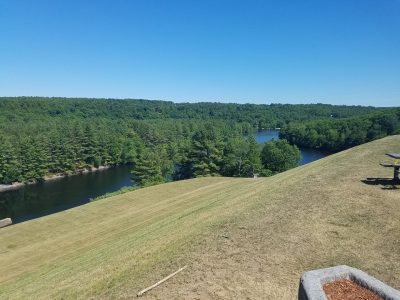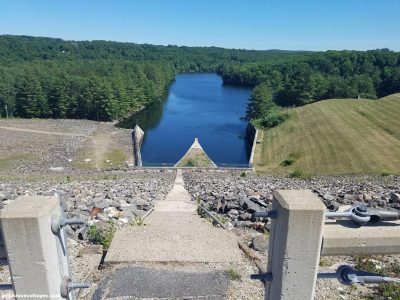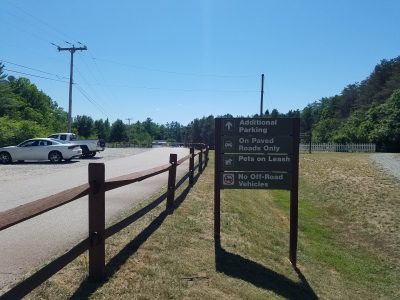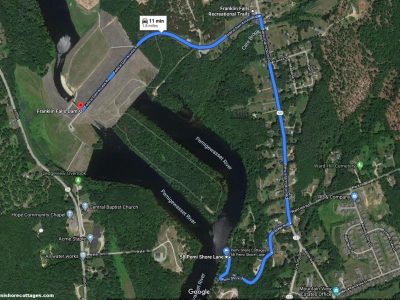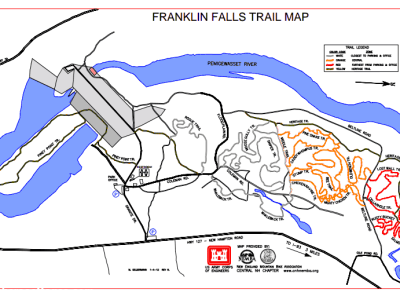Frankin Falls Dam
Franklin Falls Dam: A Beacon of Flood Control and Recreation in Franklin, NH
Nestled in the scenic landscape of Franklin, New Hampshire, the Franklin Falls Dam stands as a testament to the ingenuity and foresight of mid-20th-century engineering. Completed in 1943 by the U.S. Army Corps of Engineers, this impressive structure was designed to address a pressing need for flood control in the Merrimack River basin, an area historically prone to devastating floods.
Engineering Marvel
The Franklin Falls Dam is an earthen structure reinforced with a concrete core, standing 140 feet tall and extending 2,740 feet across the Pemigewasset River. This robust design allows the dam to hold back an immense volume of water, with its reservoir capable of storing up to 2.9 billion gallons. This capacity is crucial for managing the water flow and mitigating flood risks, protecting communities downstream along the Merrimack River.
Historical Context
The impetus for the dam’s construction arose from a series of catastrophic floods in March 1936, which underscored the need for comprehensive flood management solutions. Between 150 and 200 lives were lost from the devastation of this event. In addition, property damage in New England was estimated to exceed $100,000,000. In response, President Franklin Delano Roosevelt signed into law the Flood Control Act of 1936. The U.S. Army Corps of Engineers started the Franklin project in 1939 as part of a broader initiative to create a network of flood control dams throughout the region. Since its completion, the Franklin Falls Dam has significantly reduced the frequency and severity of floods, safeguarding lives and property.
Environmental and Recreational Impact
Beyond its primary function of flood control, the Franklin Falls Dam and its surrounding area have become a haven for outdoor enthusiasts. The reservoir and adjacent lands offer a variety of recreational activities, including hiking, fishing, boating, and picnicking. The Franklin Falls Reservoir, with its tranquil waters, is particularly popular among anglers and kayakers, while the trails around the dam provide scenic vistas and opportunities for wildlife observation.
The area is managed to balance both human use and environmental preservation. Efforts are made to maintain the natural habitats around the reservoir, ensuring that local flora and fauna continue to thrive. This dual focus on recreation and conservation has made the Franklin Falls Dam area a cherished local resource.
Community and Economic Benefits
The dam not only protects and enhances the quality of life for residents but also contributes to the local economy. The influx of visitors drawn by the recreational opportunities supports local businesses, from bait shops and outfitters to restaurants and lodging establishments. Moreover, the dam’s presence has boosted community resilience by providing a reliable defense against flooding, fostering a sense of security and stability.
Looking Ahead
As climate patterns shift and extreme weather events become more common, the role of the Franklin Falls Dam in flood management will only grow in importance. Ongoing maintenance and potential upgrades will be necessary to ensure it continues to function effectively in the face of new challenges. The U.S. Army Corps of Engineers remains committed to the dam’s upkeep, recognizing its vital role in regional flood control and community well-being.
In conclusion, the Franklin Falls Dam is much more than a flood control structure; it is a multifaceted asset that serves as a cornerstone of safety, recreation, and economic vitality in Franklin, New Hampshire. Its enduring presence underscores the successful integration of engineering prowess with environmental stewardship and community enhancement.




